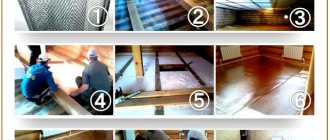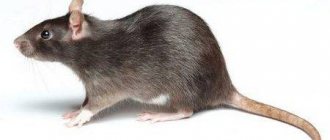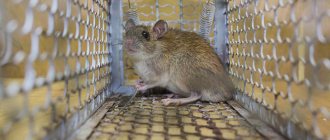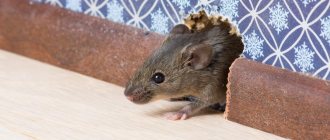How to get rid of mice in an apartment forever?
Among the 100 species of rodents common in Russia, the most famous are the field, house and forest mice.
Accordingly, during the “hungry and cold” season - which is from early September to November - they break into people’s homes, causing considerable discomfort to its residents. In addition to damaging furniture and other interior items, eating everything they meet on their way - from wallpaper to clothing, these rodents instill primitive fear in some. Doing this quickly is not always possible. Mice and rats are cunning and dexterous rodents, so you need to be patient to deal with them. In addition, the number of one colony sometimes reaches 120-150 individuals - coping with such a number of rodents quickly is quite a difficult task.
You can resort to traditional methods, which we will talk about later, or you can use modern methods - as they say, to your taste.
This is something that is not audible to the human ear, but can cause severe anxiety for rodents - to the point that they leave the place where there is this kind of irritant. There is nowhere to hide from it - invisible waves fill the entire space, being a “headache” for mice, disrupting their life cycle and reproduction.
Models of devices are provided for both large rooms and smaller rooms - usually the manufacturer declares efficiency for the maximum area - in reality it can differ by 20%. To completely eliminate rodents, it is necessary for the device to operate continuously for about 7 days.
• Ultrasonic;
• Electromagnetic;
• Combined.
Folk remedies
Among the folk methods of control there is gypsum, which is mixed with flour in equal parts and placed in different containers, which are then placed in places where rodents accumulate or near their burrows. It is necessary to leave water for the mice near these containers, since the eaten mixture of flour and alabaster will inevitably make the animals thirsty.
Also an effective remedy for mice is ash - more precisely, the alkali it contains, which can cause inflammatory processes on the paws, and then in the mouth of the rodent. Broken glass also has a damaging effect - the main thing is that the fragments are small.
Traps and mousetraps
Mousetraps are a method that has long been popular. However, if there are too many rodents in the room, one such trap may not be enough, so it is better to install several mousetraps in different rooms. For better effectiveness, use pieces of food that emit odors that attract rodents - sausage, bread, lard. Today, electric mousetraps have been developed - the high-voltage discharge of which instantly kills the animal.
Chemical compositions are special substances that are placed along walls and in places where there are large concentrations of mice. Mixed with sugar or grains, it becomes an attractive place where animals find food and, subsequently, death. It is better if the poison changes periodically - this is necessary so that rodents do not develop immunity to the same substances over time. Otherwise, it will lose its effectiveness, and insects will continue to “live and thrive” in your home.
Glue - the essence of its work is to immobilize an animal that falls on cardboard or plywood with a composition applied to it. The glued animal cannot leave, and sometimes several rodents fall into this trap at once. A small drawback of such a fight is the squeaking and “fussing” that the animal can make in an attempt to come unglued and run away.
An example of such a trap is the Medilis glue trap (detailed characteristics and method of use can be found here). This is an effective rodent control product with a non-toxic sticky composition. The trap should be placed in a place where rodents constantly move and left for 1-2 days. In this case, the area of the premises should be taken into account - calculation - 1 trap per 10 sq. m.
After a couple of days, the traps must be inspected - they may either have animals attached to them, or be contaminated with dust - in both cases they become unsuitable for further use. It is important that other pets do not fall into such a trap - it is better to temporarily transport the animal. Although the drug has low toxicity, it is important to ensure that it does not get into the eyes - if this happens, be sure to rinse the mucous membranes with plenty of running water.
Today, the total extermination of rodents in premises can be carried out with the help of special services that use professional means that are most effective in controlling rodents and minimally toxic to humans.
Professional help is sought when other methods have not proven effective, or there is simply no way to deal with the issues of eliminating mice. The method is paid - in different regions the price can reach from 3 thousand for a small room. But most often it justifies itself - deratization is carried out by specially trained people who know exactly where and how to spray the composition.
The disadvantages of this treatment are high toxicity to other animals, the mandatory use of personal protective equipment, as well as the uncontrolled death of animals, whose corpses can cause strong odors in the treated premises.
Conclusion
Methods of rodent control largely depend on the premises and size of the colony. If one of the methods turns out to be ineffective, they can be successfully combined - in this case, it is necessary to take into account the presence of pets - if a poisoned mouse is eaten by a cat or dog, the pet will be poisoned, which may result in death.
Traditional methods
Before laying the floors, you can add various slag, ash, tobacco dust, mint or dry wormwood to the insulation. Rats cannot stand the smell of these substances. When laying the foundation, it is recommended to sprinkle broken glass into the cement. When the rats gnaw on it, they will certainly cut their gums and mouth on the glass, and are unlikely to continue drilling work.
When you are leaving somewhere and the house is left unattended for a long time, you can hang bunches of dried mint or wormwood around the perimeter of each room in each corner. Small branches can also be placed near the baseboards on the floor.
Rats do not like the smell of burnt fur . Especially your own. But if it is not possible to find tufts of rat fur, you can take any, set it on fire and fumigate the room. But remember the fire safety rules . Do not accidentally drop smoldering wool on the floor or carpet. Use a glass jar for this. If you have dead rats, you can burn them. There will be an unpleasant smell for some time, but soon it will disappear and you can live in peace. The rats won't come back anymore.
For the same purpose, block houses are treated with concentrated solutions of lime or borax. Rats also try to avoid these odors.
Simple wormwood repels rats and mice
This is perhaps one of the most effective ways to get rid of rats. Poisons instantly kill parasites, wherever they are, and kill en masse, since poisoned baits can be spread out in a variety of places. However, poisons also have their drawbacks.
It is never known where a rodent will go to another world. This can be either in a visible place in the house or under the floor, from where corpses are practically impossible to pull out. Therefore, it is best to place poisons along with traps, so there will be a higher chance that they will die on the surface.
It is better to buy poisons that mummify corpses . There are a lot of these in specialized stores now. They may cost more, but if a rat eats such poison, then its corpse will not emit corpse vapor, which can cause poisoning in humans. In this case, the location of the baits does not matter.
When laying out baits with poison, you must also take into account the fact that your pets or, what is even more dangerous, children may be in the house. They may accidentally eat or touch poison and become poisoned. To prevent this from happening, baits should be placed in places where small children, cats and dogs cannot reach them. And also decorative hamsters and rats that can walk on the floor.
What are the dangers of a mouse infestation?
So, let's see what difficulties ordinary house mice can create under the floor:
- Constant noise at night.
- Gnawed cables, wires and pipes made from certain materials.
- Insulation materials turned to dust.
- A specific and not very pleasant “mouse” smell in the house.
- Found mouse waste in the morning wherever possible.
- Danger of contracting rodent-borne diseases.
READ MORE: Warm floors or radiators, which is better in a private house The answer is here
And also such unpleasant phenomena as a dead mouse under the floor, which is not easy to find and pull out.
Now imagine that in a year a female gives birth to up to 7 mice in each of 10 annual litters. Those. in 12 months there will already be 60-70 new rodents in your house! And each mouse matures within just three months, and also begins to reproduce. At the same time, mice are fast animals: they can reach speeds of up to 12 km/h, jump up to 75 cm in length, and up to 40 cm in height. Just don’t let this problem take its course - they will eat the house too.
What attracts rats and why they are dangerous
For Pasyuks, the search for food and procreation come first. They have long realized that these instincts are best satisfied near a person’s home, so they try to settle where they can feast on food waste, slop and other things. They are attracted to indoor odors, so they are rarely found in places that are clean and tidy.
Tailed rodents are omnivores and use all possible ways to get to leftover food.
Rats really like shops, warehouses and pantries that store grains, flour, all kinds of cereals and similar food supplies. Food industry enterprises, including cafes and restaurants, are their favorite habitats.
The fact that rats destroy food and damage property is not the most important reason why you should get rid of them. It is also necessary to protect yourself from toothy pests because they are carriers of dangerous diseases, such as tuberculosis, scabies, plague, typhoid and other rapidly spreading infections.
Rats chew on everything, including cables, and this often causes serious damage and fires.
Rats can live anywhere - in the basement, utility rooms, chicken coop, garbage chute, entrance, etc. The owners of the house can hear their stomping and rustling. A rat can infect humans with many diseases through food. The most common diseases:
- yersiniosis;
- leptospirosis;
- tularemia, etc.
Every rat is a carrier of blood-sucking insects, which can also spread infectious diseases. The most dangerous are black and brown rats. In the Middle Ages, they were the carriers of such dangerous infectious diseases as typhoid and plague.
Why are mice dangerous?
In general, “neighborhood” with rodents can even result in severe infections for humans - these are sources of rabies, leptospirosis, toxoplasmosis, parasitic diseases, hemorrhagic fever, tularemia, plague, typhoid, cholera and other infectious diseases that, if not diagnosed in time, can be fatal . In addition, mice can become a source of fleas and infect your pets.
They carry this infection on their paws, while being a reservoir, the mice themselves do not suffer from these infections. Infection is possible through contact - bites, contact with a corpse, inhalation of air and dust in a room where there is a high number of rodents - they contain particles of hair and mouse droppings, which can cause not only infection, but also allergic reactions.
There is also a high risk of contracting an infection when drinking water containing mouse feces. The alimentary route (through the mouth) can also occur when eating food that has been walked on by rodents - this is how they will bring an infection to their paws.
Squeak of decorative mice
Usually, animals express their dissatisfaction with the conditions of detention or report a painful condition with loud exclamations. The mouse can squeak:
- under stress;
- lack of water or food;
- during illness;
- due to itchy skin as a result of infection with ectoparasites;
- with allergic dermatitis, when the skin is flaky, painful and inflamed.
It is believed that a small rodent can squeak for about a week after changing its place of residence - and this is the norm, since it takes some time to adapt to a new home.
It is important to never add new residents to an already established team, otherwise you will end up with a real mouse booth, which will ultimately end not just with indignant exclamations, but also with the murder of the uninvited guest. In the latter case, a desperate whistle will be heard guaranteed.
Illness is another reason for squeaking. At the same time, it will be more like crying - loud, pitiful and prolonged, only intensifying over time. If you suspect health problems, you should carefully examine the mouse to see if it has any damage, or show it to a veterinarian. True, finding a good ratologist (rodent specialist) can be problematic, especially in small provincial towns.
By the way, in some cases, disturbances stop when the type of bedding is changed or the nest where the small gray cub lives is thoroughly cleaned.
Often, owners mistake chest whistling or wheezing due to breathing problems as a result of a cold or pneumonia for a squeak. If pneumonia or bronchitis is suspected, the animal is transplanted into a separate container (quarantine) so that the rodent does not become a source of infection for other pets, and the dynamics of the process are carefully monitored. If the condition worsens, antibiotics and vitamins may be required.
Where do mice come from under the floor?
The main goal of mice is food. The secondary goal is to build nests and reproduce in the house where the food is. And mice can smell food two kilometers away! (Note that the bear is only a little larger - for five). That is why, if you leave your country house or bathhouse closed for the season, remove from there everything that could attract these animals.
Frame houses are especially targeted because of their design. Such a house can be built very quickly, quite inexpensively and at the same time fully meets all the requirements. But mice in its walls and floor are a real problem. An invasion of rodents into such a house can begin at the construction stage, but it is difficult to get rid of such pests.
But even the most durable, serious building made of bricks or blocks also rarely manages to avoid the proximity of tailed animals - after all, they love to settle under the floor. And, if the walls can somehow be protected with metal sheets, then it is more difficult to drive a mouse out from under the floor. And with the arrival of cold weather, this beast will find any opportunity to get underground.
Although the mice themselves are different. Thus, in the warm season, voles make their nests in the open air - under boards, near garbage. Until autumn they actively reproduce, and at the first cold weather they go into any enclosed space. Moreover, they can get under your floor even through the slightly open front door and right in front of the owners! But domestic mice don’t really peek out from under the floor at all. Moreover, cats easily get used to the smell.
Intimidation method
To prevent mice from appearing in the apartment or leaving it, repellers are actively used: ultrasonic, electromagnetic or combined. It all depends on the method of influencing animals. In the first case, sounds are generated at frequencies that are beyond the sensitivity of the human ear, but are irritating to mice. In the second, the emitter generates electromagnetic waves that irritate the nervous system. A combination device combines these two methods. In all cases, panic and irritation are sown, and the mice leave the “restless” place. The product is safe for both rodents and humans, as well as pets. “Spectrum” is in particular demand: its coverage area is 300 sq. m., it is not afraid of high humidity and voltage surges in the network.
Signs of mice in the house
The main ways from which uninvited guests can enter your home are the basement, sewers, ventilation pipes, and garbage chutes. There are direct signs that mice have entered your home:
- Holes in walls and floors are passages that rodents need to move freely around the apartment;
- Mouse droppings are small black oblong feces;
- The smell is sour and musty, easily recognizable;
- Sounds – if during the day mice can make a slight rustling noise when moving, then at night, especially if there are large concentrations of them, quite loud sounds can occur under the floor and behind the walls, accompanied by a characteristic mouse high-pitched squeak;
- Wary behavior of a cat - if the pet constantly sniffs and looks for something, freezes in one place for a long time - perhaps he is hunting for mice, the presence of which you do not even suspect.
Preventive measures
Preventive measures have been discussed more than once. The main principle is this: there are no pests in a clean house.
Therefore, adhere to simple rules:
- They constantly carry out general cleaning, during which they find and throw away all found garbage that is not of household or other interest;
- do not leave scraps on the table, under the table, but promptly put them in a trash can with a lid;
- do not clutter the house and apartment with unnecessary things;
- all products are kept out of reach in tightly sealed containers;
- They periodically inspect the residential area, seal up any mouse holes found, having previously prepared an unpleasant surprise for the rodent using poison or a mousetrap.
Fighting mice is not an easy task, but you can cope with the task. The main thing is to approach the issue with ingenuity and knowledge of the matter.
Insulation and rodents: is there a solution?
Let's be clear right away - most modern floor insulation materials really don't eat mice, but at the same time they live quietly in them. And they also build nests in soft ones.
Fun fact: Mice's teeth grow throughout their lives. Moreover, if the mouse does not constantly chew something, then these teeth will grow into its upper jaw. Therefore, gnawing is a daily need for this animal. And the mouse can even sharpen concrete walls.
Oddly enough, mice are especially often found in polystyrene foam. Moreover, they gnaw on it - but not with the goal of getting enough, but with the goal of building comfortable nests in it. And therefore, manufacturers recommend insulating walls and floors with ecowool, which is looser and creates an antiseptic environment. But mice also gnaw on it, although not so willingly.
After all, as practice shows, mice can live under the floor in ecowool, foam plastic, and almost any other insulation. Even in glass wool! However, it is worth noting that it is very difficult, almost impossible, for a mouse to chew through ordinary plywood and OSB boards. All because of the structural features of her teeth. Like slabs that have a layered structure with wood chips directed in different directions.
READ MORE: Attaching the toilet to the floor on tiles
The secret of the survival of these animals in any conditions is their extreme unpretentiousness. That’s why they gnaw holes for themselves in anything, in a word.
Why at this stage? Yes, because it is much easier to prevent a rodent invasion than to fight them later. And the myths that there are no barriers for mice who want to get into the house are still myths. With a creative and attentive approach to this issue, you can completely ensure that such a misfortune never occurs in your home or bathhouse.
But first, you can carefully study the current building codes, which list grilles, metal screens and other methods of protection. But remember, when installing a metal profile against mice, you must leave a gap so that the insulation does not get wet from condensation.
Here we are talking about the so-called “expanded clay castle”, when a layer of expanded clay is laid especially tightly and at least 10 cm thick. Here is a standard floor pie that is protected from mice during the construction of a house:
- 1st layer: lay expanded clay (fired clay) directly on the ground. The layer should be at least 30 cm thick. Cover with plastic wrap.
- 2nd layer: lay OSB-3 boards in two layers.
- 3rd layer: put expanded clay again.
- 4th layer: cover with oriented strand boards impregnated with synthetic wax and boric acid. These substances are good at repelling rodents.
As you can see, nothing complicated.
The simplest and most effective method of mechanical protection against mice even at the construction stage can be called galvanized mesh. It should be made of durable metal and with small cells. Much smaller than you now imagine. Now we will explain why: the mouse’s skull has the ability to “fold”, like that of a newborn, and therefore this animal will really fit where a pencil fits, as biologists like to say.
If possible, cover all corners (floor, wall, and ceiling) with mesh, which is usually used for plastering. Don't miss a single connection.
Sometimes this material is used to protect against mice even after construction, when a problem with rodents becomes obvious. To do this, bury it around the foundation to a depth of 80 cm. If you notice already dug holes, then go even deeper. And place a mesh at least a meter high under the plinth sheathing.
The foundation of the house is also sheathed with a 1.5 mm profiled sheet of structural steel. This is also good additional protection.
If you are satisfied that there will still be a small number of mice under the floor, but will not penetrate into the house itself, then make a cake like this:
- Step 1. Forget about insulation. A floor without mice is a floor without any cotton wool or polystyrene foam. Just make a shield - a floorboard right along the joists.
- Step 2. To prevent mice from getting into the gap between the edge of the floor and the outside sheathing, cut 10 cm strips of galvanized steel and nail them on top of the floor.
- Step 3: Cover these strips at the top with insulation and sheathing.
These are the simple, proven recipes. The main thing is don’t give up!
Effective methods of protecting a frame house from rodents
Measures to protect against various rodents entering your home may vary. The most effective measures to prevent rodents should be taken before building a house.
Exist:
- active (various poisons, mousetraps, etc.);
- passive methods (grids, insulation, use of special solutions).
Passive methods of protection
Passive methods of protecting frame houses are used before and during construction, which will help avoid rodent infestations in the future.
The mesh is a steel structure made of wire and consisting of additional small cells. It is one of the most effective methods of passive protection against pest penetration. The wire should in no case be thin, at least 2 millimeters thick
This point is worth paying special attention to, since rats can easily gnaw through the thin structure.
Since the design of the house contains thermal insulation blocks, which are a very attractive refuge for rodents, special attention should be paid to this point. Thermal insulation blocks must be coated with a special solution of lime and borax, and then the blocks must be rolled in with universal insulation - ecowool
The coating should be very dense.
The best way to protect a frame house from rodents is to install a reinforced concrete monolithic slab at the base of the house. The slab must be filled with expanded clay. Thanks to this, rodents will not be able to enter the house.
Active methods of protection
If the house has already been built, and the protection installation technologies did not bring any effect, or were not designed correctly, then it is necessary to resort to active protection methods.
Poisons and poisons
There are many different chemicals available to kill rodents, but when used, there is a risk of poisoning pets or children. Therefore, when using various poisons, you should be very careful.
Poisons such as rat poison, poison, and various powders are used to suffocate rats and mice.
Mousetraps
A mousetrap is a simple method that has been proven over the years. There are different types of mousetraps: mechanical and humane mousetraps that do not kill rodents.
Repellers
Installing ultrasonic and other repellers is the most humane way to get rid of rodents, as well as one of the most effective.
They are an electronic structure that emits ultrasonic or electromagnetic waves in various frequency ranges. This sound is extremely unpleasant for rats, mice and moles, as it has a depressing effect on the nervous system of rodents, but the sound does not cause any inconvenience to humans. Currently, repellers such as, are available in stores.
*The numbers in the names of the repellers indicate the area of effect in square meters!
It is also an effective means of catching rodents. Once on the surface of the trap, rodents cannot move.
What are mice afraid of?
This question has not left people for many centuries - mice and rats have always stayed close to human settlements, causing damage to property and spreading deadly diseases. However, in the meantime, methods of fighting rodents have also evolved - people have gradually learned to eliminate uninvited guests, and with them the troubles that they can cause.
It was already mentioned above that mice become the most active in the fall, when their mass migration is observed closer to villages and cities in search of food and shelter. To prevent mice from staying in your home for a long time, it is important to carefully observe hygiene rules. Where there is no food left on the tables, no crumbs on the floor, and all food is sealed in bags or hidden in the refrigerator, mice do not stay long.
- Lack of water. Water is a must for rodents to live. If for one reason there is no access to water, the rodents die within 4-5 days;
- Lack of food - the number of colonies decreases over a longer period than from dehydration - rodents die within a month in the absence of food;
- Cold. This factor has little effect on the animals themselves. But for the reproduction cycle - directly. In a human home, rodents are able to reproduce 10 times a year, whereas in natural living conditions - only 2-3 times;
- Cat - capable of eliminating up to 1-3 mice in one night. It is known that mice are afraid even of cat smell (urine), so they try to avoid such houses.
The answer is clear – high-frequency. Anything above the normal range of mouse hearing - 30-110 kHz - is irritating to rodents. The work of ultrasonic repellers is based on this scientific fact, the waves of which can rid your home of rodents forever - it becomes simply unsuitable for their further residence.
Fighting rodents with folk remedies
I will tell you one old way to get rid of rodents in your basement and cellar. People call it dirty. And that's why.
Getting rid of rodents using ash
You need to take wood ash and grind it finely, and then sprinkle it on the dry floors of the basement and cellar at the rate of one bucket per 5-10 m2, of course, only in those places where it will not interfere with you.
The ash contains alkali, which corrodes the paws of rodents. They lick it off, which causes further irritation to the mouth and stomach. Therefore, rats and mice are forced to move to another place.
For humans, unlike mice, ash is absolutely harmless, which is why the method I described is good. But there is also a disadvantage to this means of getting rid of rats and mice, because the “tailed ones” spread ash throughout the house and this does not make it cleaner.
Fighting rats and mice using culinary methods
There is another original method of fighting rodents in my collection of folk wisdom, I call it culinary. Wheat flour and building gypsum (alabaster) are mixed in a 1:1 ratio and this dry mixture is poured into a container.
Water for drinking is placed nearby. The bait has a familiar smell and does not arouse suspicion. The essence of the method is that after eating and drinking, a rat or mouse gets specific indigestion, since after a few minutes the mixture hardens like cement in the rodent’s stomach.
In our village, sometimes instead of flour and alabaster they used a dry mixture of quicklime and sugar. And there is another tricky way - take a wine cork and cut it into small pieces with a knife, mix it with finely chopped crusts of bread, and flavor it with a few drops of unrefined sunflower oil.
When this culinary delight gets into the mouse’s stomach, the plug begins to swell and gets stuck in the mouse’s intestines. Did you know that rats are very sensitive to human smell? Therefore, when preparing bait for them, you need to use something plastic or wooden, it could be a stick or a spoon.
You can wear rubber gloves. Before spreading the bait, the rats must be fed normal food for several days. And only then food with a “surprise” is placed in the same place.
Traditional methods of protecting floors from mice
If you still have mice under the floor, you can also contact a professional service. They carry out a special treatment that allows you to forget about rodents for a whole year. This is the simplest, although not the best option. There are other traditional methods.
When laying the floor, add ash, slag, tobacco dust, dry wormwood or mint to the insulation - mice really don’t like all of this. Some also add red hot pepper or a lot of broken glass.
Moreover, the smell of dried mint has a suffocating effect on the mouse. While you are away from the house, you can even hang this plant in different corners - this really helps.
Underground mice do not like not only mint, but in general anything that smells strongly and unpleasantly. The aroma of burnt wool is especially disgusting for them - some even use it to fumigate the room, and throw the burnt remains under the floorboards. Mice do not like this smell and usually retreat from such places.
READ MORE: How to make a floor in an apartment with your own hands, inexpensive options Step by step
Also, when building a house from blocks, builders often treat them with borax or lime solutions. Everything is the same.
Glue traps are the most popular today. So far, the best reviews are for ALT glue, which is not expensive and quite sticky. It needs to be applied to a piece of plywood in the form of a circle, and a drop should be left in the very center. We put bait on it, and even if the mouse touches the glue with just the tip of its tail, it won’t go anywhere.
Note that wire spring traps are least suitable for a private home in the fight against mice - if there are already a lot of holes and passages near the house, you will then have to dig out these pieces of iron on the site for a long time.
But, if the rodents have already multiplied, such a fight against them can be exhausting.
But pesticides have a significant disadvantage: firstly, they can accidentally poison a pet, and secondly, no matter how the sellers claim that mouse carcasses quickly mummify and do not emit odors, in fact they decompose for quite a long time in hard-to-reach places, and it is impossible to live in the house during this period.
Therefore, if you use pesticides, then scatter them under the floor only in early autumn - when rodents gather to stay.
This is a new word in the fight against mice under the floor. After all, there are no barriers to ultrasound. So, they are small devices that, when turned on, produce a sound of a frequency inaudible to humans, but for rodents it is quite unpleasant and affects the nervous system.
When choosing such a device, you should carefully choose the manufacturer and not save money, otherwise the cat may run away from the house. And ultrasonic repellers are not always safe for people. We can say that this issue has not been fully studied, and yet some part of the population hears a thin squeak when the device is turned on, which a priori should not be heard.
The range of modern repellers themselves is very diverse - and among such devices there are many that have a noticeable effect, but do not give 100% results.
Thus, the most powerful repeller to date is “Spectrum”, which covers up to 300 square meters. For an underground space, this is the best choice: it works without interruption for several years, and can withstand high humidity in the basement and voltage in the electrical network. If the electricity is turned off, then the device will turn on itself, and therefore it is convenient to install it in a country house or bathhouse, where you are absent for months.
Also, ordinary people recognize such repellers as “Typhoon”, Weitech WK-0300, WK-0600 CIX, “Grad A-500” and “GRAD A-1000 PRO” as quite effective. They have a fairly powerful and expensive base, a wide radiation pattern and a constantly changing ultrasound frequency, which ensures that rodents do not get used to it. Pestchaser 360 M, Pestchaser 360 and “CHISTON-2 360” are already less popular.
And the cheapest repellers have weaker technical components and low power. Rodents get used to them quickly and on the very first day. These brands are Weitech WK-0220, Pestchaser LS-968, Pestchaser AC/DC and Weitech WK-0240.
If you decide to fight mice under the floor in this way, be sure to study the certificates included with your purchase. Otherwise you may end up buying a fake.
So, the most terrible animals for mice are cats and ferrets. Moreover, the latter are much more experienced and dexterous in this regard! Get such a pet - you will be surprised.
As for cats, not all breeds of this family like to catch mice. And cats are completely lazy. But rodents are more afraid not so much of the rare chance of getting caught as of the smell of the predator itself. That’s why some craftsmen scatter cat hair under the floor – and this is an excellent and effective method.
You will also be interested to know that a cat is not just a predator that likes to eat mice. This is a real biological weapon against the latter. So, in cat excrement there are special substances that act on the consciousness of rodents, and they already behave more fearlessly - and are easier to get caught (which is why cat owners who are not very hygienic often, having lost the same sense of danger, end up in accidents more often than others - there are such research).
A breed of dog such as the American Staff Terrier is also bred in America. These are real rat catchers, and they are bred specifically for farmland instead of cats. They are also great at catching mice, although they don’t eat them. Speaking of breeds: the more decorative a cat is, the less prone it is to natural hunting, and therefore it is better to give preference to an ordinary yard Murka. And finally, it is worth noting an interesting fact: what mice are most afraid of is not cats, but rats. And in the house where there is one rat, there are usually no mice.
Fighting methods
If rodents were able to enter the room, you need to think about how to get rid of mice in a frame house. There are many ways. It is necessary to take into account the number of pests and the structural features of the frame house.
Ways to control rodents
Using poison is not the best option, since the mouse can die in the wall, and the cadaverous smell will spread throughout the house. Even if a product with a mummifying effect is used, an unpleasant odor is present, although not so strong. Mice in a frame house must either be caught or driven away.
You can catch a mouse using traps, store-bought traps, or you can make mousetraps with your own hands.
- One of the options for making your own is a plastic bottle. Cut off the neck. Mouse bait is placed inside and the walls are coated with sunflower oil. Place the neck inside the bottle and secure it with tape. Leave the trap in any room. The mouse easily climbs into the bottle through the narrow neck, but the slippery walls prevent it from getting out.
- Water is poured into a bucket, husks, straw, leaves are crushed on top, a spoonful of vegetable oil is poured, seeds and grain are sprinkled. A ladder - a stick - is placed next to the bucket. The mouse crawls for food, falls into the water, and drowns. The top layer is restored, and another rodent may fall into the trap.
- A sticky trap is one of the simplest, most convenient ways to catch rodents in the country. Making a trap yourself is not difficult. Rodent repellent glue is applied to plywood, thick cardboard, and oilcloth, and the base is fixed to the floor so that the mouse does not drag the trap with it. The bait is placed in the center. The rodent sticks its paw, tries to get out, but falls even further into the trap. Several pests can be caught at once. But the biggest drawback is the cries of animals, which you don’t want to listen to in a residential building.
Repellent
You can drive mice out of the frame using an unpleasant odor or sound.
- Bunches of peppermint, chamomile, tansy, and wormwood are stuffed into holes along the walls. Such plants do not allow the mouse family to live; you can use mouse grass for prevention.
- The floors are washed every evening with a solution of vinegar and ammonia. Concentrated preparations are left in a saucer on the floor.
- You can wash the floor with water with the addition of essential oils of mint, lemon balm, and citrus. Rodents do not like these smells. If you were able to start in a frame house, you need to prepare for daily evening procedures with washing the floors.
The modern repellent method involves the use of a professional device - an ultrasonic rodent repeller. The market can offer products from domestic and foreign manufacturers. Based on customer reviews, it is difficult to understand whether the device works or not; there are conflicting opinions. There are many positive reviews about the effective devices Typhoon and Clean House.
You won’t have to fight mice every season if you take drastic measures. Change the insulation, install metal mesh. If you have already received a frame house with rodents, you must first get rid of the mice in it, then begin arranging the mansion.
Rats in a private house
If there are rats in your home, we are very sorry. Wild rodents living near you carry dangerous diseases and should be destroyed as quickly as possible.
The most important thing is to determine how rats enter your home. It is very important to do this, otherwise after you get rid of the rats, they may return in the same way in a month, in a year or even in five years
If you live in a private house, most likely the reason lies in the design of the house. Check the building for broken windows, missing bricks in the masonry, and cracks where sewer and water pipes pass through. You should be interested in all holes larger than 5 centimeters.
Move away all appliances and furniture to make sure there are no holes or cracks in the floor that rats could get through. Also check all baseboards carefully.
Any cracks and holes found must be sealed with high-quality building mixtures mixed with small shards of broken glass. The glass will discourage rats from making new passages in newly filled holes.
If rats are coming from under the floor, remove a few floorboards to thoroughly check the area under the floor for rat nests. Also carefully check the foundation base for cracks. If you do not find any signs of rats, and the foundation is secure, then most likely the rats came from the sewer or through cracks around the pipes.
Finally, inspect the roof and attic spaces for signs of rats. Check all wooden surfaces for signs of rat teeth and possibly droppings. However, droppings are not evidence that rats have chosen this particular room to live. They, unlike mice, who shit anywhere, choose one place for the toilet and, as a rule, not where they live.
Now you must carefully plan your actions and think about what means to fight rats. It is best to use various mousetraps in the house. It is wiser to avoid rat poison: a rat can die in a hard-to-reach place and will cause a very unpleasant odor.
The most effective are regular mousetraps and traps with a sticky surface. For bait, use bacon, chocolate, nuts (no rat can resist unshelled peanuts). Peanut butter, apples, tomatoes and potatoes are good options.
Unfortunately, mousetraps create a new problem - what to do with a caught rodent? Take it away from home? Where is the guarantee that the rat will not return and you will release it more than once? Vicious circle.
More modern means can be used. The simplest and most convenient are ultrasonic repellers. If you have no idea what you will do with a caught rat, and are not eager to look for the corpses of rodents, this will do just fine. The compact device operates in the ultrasonic range, which is not perceived by humans and animals. For rats, this is a danger signal. The instinct of self-preservation forces them to leave their homes.
The advantage is that you don’t have to think about where to put a live rat from a mousetrap or look for where a dead rat is under the floor to get rid of the unpleasant smell. The device is plugged into the outlet and dangerous rodents leave your home on their own.
Removing uninvited guests from your home
Herbs are not only safe, but also poisonous. If there are children or animals in the house, then it is better not to use toxic products or place them in hard-to-reach places.
Dried herbs are collected in bunches and placed in the corners of the room where pests most often live. The herbal scent has a beneficial effect on the human body, calming the nervous system and eliminating headaches. You should consider which herbs can be used in houses and apartments:
- Ratrunner or blackroot. The name speaks for itself: its smell repels rats and also saves from mice. For control, dried root powder, juice and decoction of rhizomes are used. You can simply dry the grass and spread it indoors. Before laying it out, the ratcatcher is scalded with boiling water so that the smell is strong. People won't feel it. It must be remembered that this plant is very poisonous. When working with it, you should be careful and use gloves.
Blackroot against rats
- Sagebrush. The aroma of this plant is tart and bitter. Dried grass is used to cover houses and sheds. The smell causes headaches and nausea in some people, so you should not distribute it in large quantities. Strong decoctions are made from wormwood, and the places where rodents appear are sprinkled with this liquid.
Sagebrush
- Tansy. People like the smell of this grass, but not gray animals. It is enough to arrange the tansy flowers and the annoying pests will disappear from the room. You just need to know that cats cannot stand its aroma, so if they are present, it is better to refuse tansy.
Tansy
- Ledum. If you place branches of this grass in different corners, rodents will not enter the house. You just need to remember that not only rats and mice can hate the smell, but also the residents of the house. Therefore, this plant should not be abused.
Ledum
- Mint. With this grass you can forget about the existence of pests. Both dried mint and an alcohol tincture made from it will help. The tincture is sprayed in places where rodents live. Dried branches are laid out there, after dipping them in boiling water.
Field mint
- Chamomile. These flowers can not only be planted, but also dried. As mentioned above, rodents hate it. Dried chamomile is laid out on the floor or collected in bunches and hung in the corners.
Field chamomile
- Autumn colchicum. All parts of the plant are poisonous to mice and rats, but the seeds have the best effect. They are placed in all pest habitats.
Autumn colchicum
- Datura. It is often planted in gardens without knowing about its poisonous properties. The fruits of this plant are especially poisonous. Rodents cannot tolerate dope. They hate both flowers and stems with leaves.
Datura
- Elder. The roots of this plant contain hydrocyanic acid. It is best to place elderberry branches underground so that they do not harm the inhabitants of the house.
Elder
- Pyrethrum. This plant is one of the safest for humans. Not only stems, but also flowers are used in pest control. The aroma will help against both mice and insects.
Pyrethrum Persian chamomile
If rodents are not constantly in the house, but appear periodically, then you can plant the desired plant in a flower pot. This way there will be no need to collect and prepare herbs. Chamomile and mint take root well at home. Moreover, they have a beneficial effect on the human body and will not cause harm if they grow in the house.
Having chosen plants for pest control, you need to determine where to place them. Poisonous herbs are placed only in places where rodents frequent or near their burrows. Safe plants are placed throughout the house. Renew the herbs placed around the house once a week.
Ultrasonic repellers
These are modern electronic devices that operate based on the generation of ultrasonic waves. At the same time, the human ear does not perceive these sounds, so they have practically no effect on it. As for animals, many of them perceive ultrasound, which is why it is used in the fight against them, especially rodents such as mice and rats.
Depending on the power of the device, it can protect a space of a certain area. At the same time, such household items as furniture, carpets, rugs, etc. interfere with the normal passage of ultrasonic waves. It is advisable that a separate device be installed in each room. It is recommended to use the device for 1 month, after which a break is taken.
Ultrasound causes a feeling of fear in rodents, therefore, they try to leave the room as quickly as possible. You can get rid of rodents within 3 weeks.
On a note! It is advisable to use ultrasonic repellers in combination with other control methods. It is known that ultrasound also has a negative effect on pets. Therefore, if the house contains hamsters, guinea pigs, etc., then it is better to abandon this device.











